
A small introduction. The exit pupil of an optical device is a small circle at the exit from the eyepiece in which all the light collected by the lens is concentrated. To calculate the size of the exit pupil, it is enough to divide the diameter of the binocular lens by increasing. For example, with 8×56 binoculars it is 7 mm, and with 10×25 binoculars – 2.5 mm. The larger the exit pupil, the brighter the image at dusk and at night. As a rule, for daytime observations, a pupil of about 3 mm is sufficient, and for astronomical observations, preferably from 4 mm and more. At night, the human pupil expands to 6-8 mm, so in binoculars usually the value of the exit pupil does not exceed 7 mm, otherwise the light at the exit of the eyepiece will go past the pupil. Binoculars, in which the exit pupil is 6-7 mm, are called PUPIL EQUAL. When this is achieved the maximum brightness of the image. If you compare 8×56 and 8×30 binoculars in the night sky, then the image brightness in binoculars 8×30 will be 3.5 times less, since with the same magnification the lens of 8×30 binoculars is 3.5 times smaller in area, and, accordingly, less light falls into the observer’s pupil.
For a long time I looked at the pupil equal binoculars. I was not impressed with the low-end models (Nikon Aculon 7×50, ZOMZ 7×50, Yukon Point 8×56), so for the time being I was using Nikon Sporter EX 8×42 binoculars. However, it was possible at a reasonable price to get used binoculars with DDoptics Nachtfalke Ergo 8×56 gen II roof glasses (hereinafter DDoptics 8×56). Initially, there was little information on this binocular, but after the purchase I found quite a few reviews of this binocular, produced under other brands. Apparently, the binoculars turned out successful, since it began to be sold immediately in various reincarnations. In general, I will not pull, proceed to the review.
The manufacturer’s stated specifications are as follows:
| Weight | 1050 g |
|---|---|
| Magnification | 8 x |
| Aperture | 56 mm |
| Exit pupil | 7 mm |
| Field of view at 1000 m | 114 m |
| Visible field of view (°) | 6,5º (measured – 5,7º) |
| Prism type |
Schmidt-Pechan |
| Mirror coating prisms | dielectric 52S |
| Lens coating | FMC H7 |
| Eyepiece: lens/groups | 4/3 |
| Objective: lens/groups | 3/2 |
| Body material | Magnesium |
| Body armor |
Rubber |
| Eye relief | 18,2 mm (measured – 25 mm) |
| Compatible with glasses | Yes |
| Close focus distance | 2,5 m |
| Diopter correction | middle |
| Dioptric compensation | +/-4 |
| Relative brightness (square of exit pupil diameter) | 49 |
| Twilight factor | 21,16 |
| Nitrogen purged | Да |
| Water proof (depth) | 1,5 m |
| Dimensions (L/W/H) in mm | 165 x 148 x 66 mm |
In box
| Neck strap | 1 piece. |
|---|---|
| Bag | 1 piece. |
| Lens caps | 1 pair. |
| Eyepiece covers | 1 piece. |
| Cleaning cloth | 1 piece. |
Equipment.
In my kit there was only binoculars with covers and a bag for carrying. The eye shields and caps hold tight. I really liked the bag – tough, strong, slightly springy – in general, an excellent shockproof case. There is a small fabric carrying handle and a detachable belt. I would replace the belt with a wider one — binoculars are quite heavy and, when carried over the shoulder, “unpleasantly” cuts ”and presses.

Housing.
DDoptics 8×56 binoculars are very compact for their parameters. Tangible weight – 1 kg. The case is covered with matte rubber, there is a ribbed surface on the sides, binoculars do not slip out of hands. In the front of the binoculars under the cover there is a thread for a tripod adapter. Adjustment screws outside are not detected – most likely, they are hidden under the rubber “armor”.
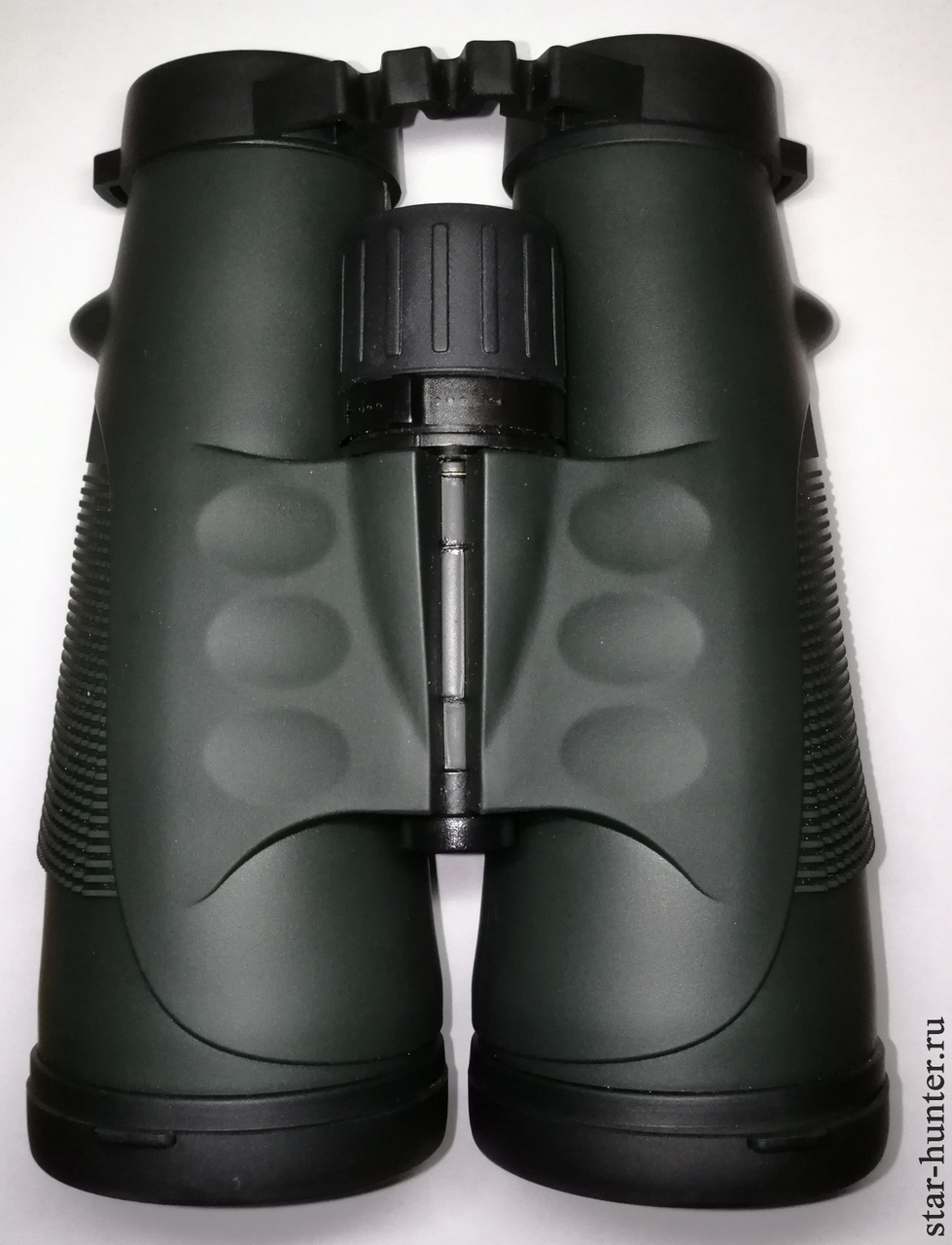
From the right eyepiece there is a slight discrepancy of the glued seam. The rubber rim of the left lens in front from the bottom is a bit “dented”, as if the result of the fall of binoculars. Whether it is caused by mechanical damage during use, or it is a defect in the assembly – is unknown.


Optics.
The measured aperture was 55 mm – 1 mm less than stated. The drop in brightness due to the cut-off aperture is 3.6%. The lenses are slightly recessed into the case, the risk of getting dirty with your fingers is small. The color of glare from lenses and prisms is green (in different shades), blue, dull, colorless (glued together in the lens). Declared the using of ED-glass lens. On closer inspection with a side-lit flashlight, a slight plaque and streaks were detected on the inside of the lens, either on the glued lens or on the second lens. I doubt that this will significantly affect the contrast of the image, but fact is a fact. Prisms are coated, clean, free of dust and debris.
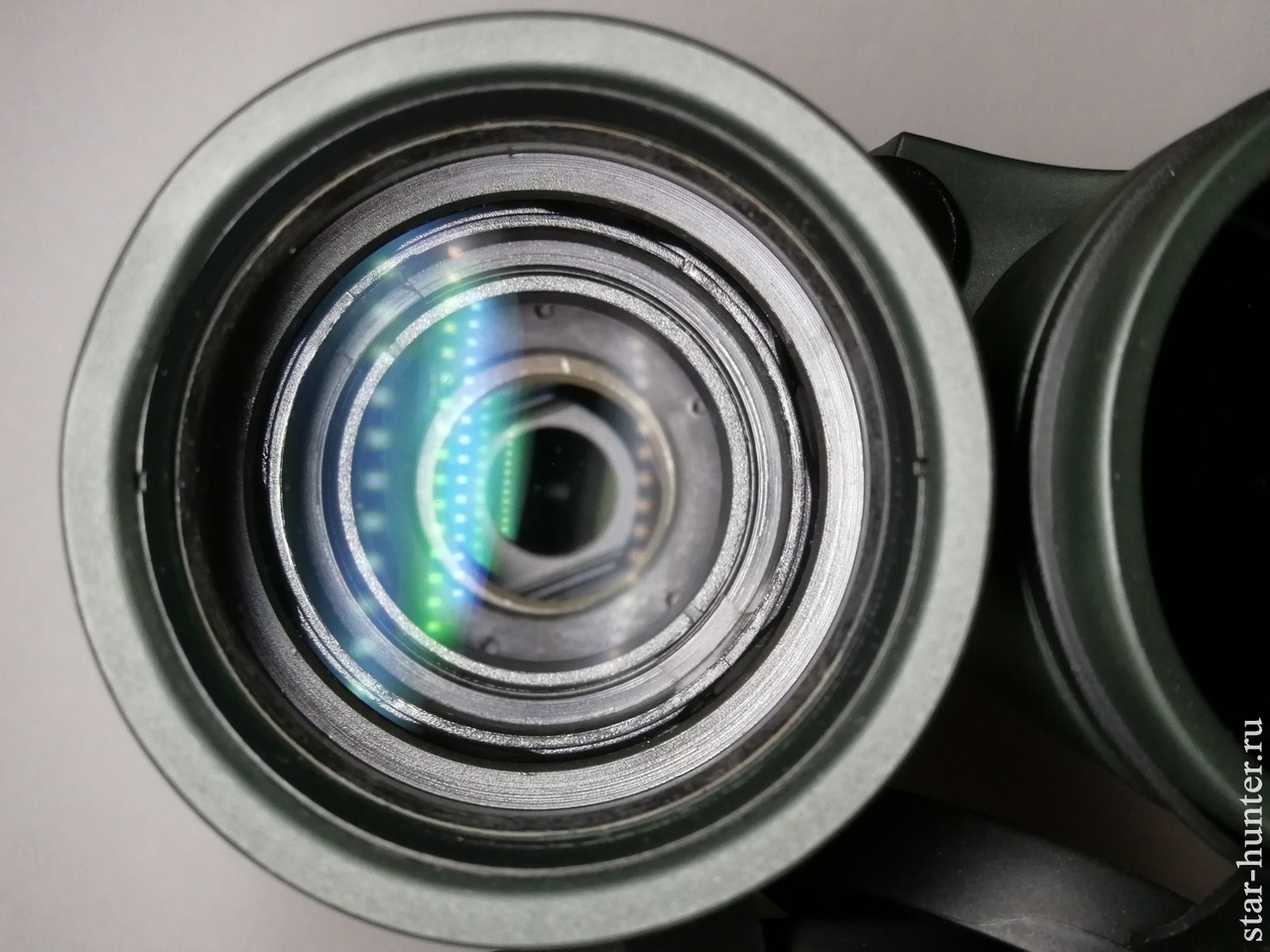
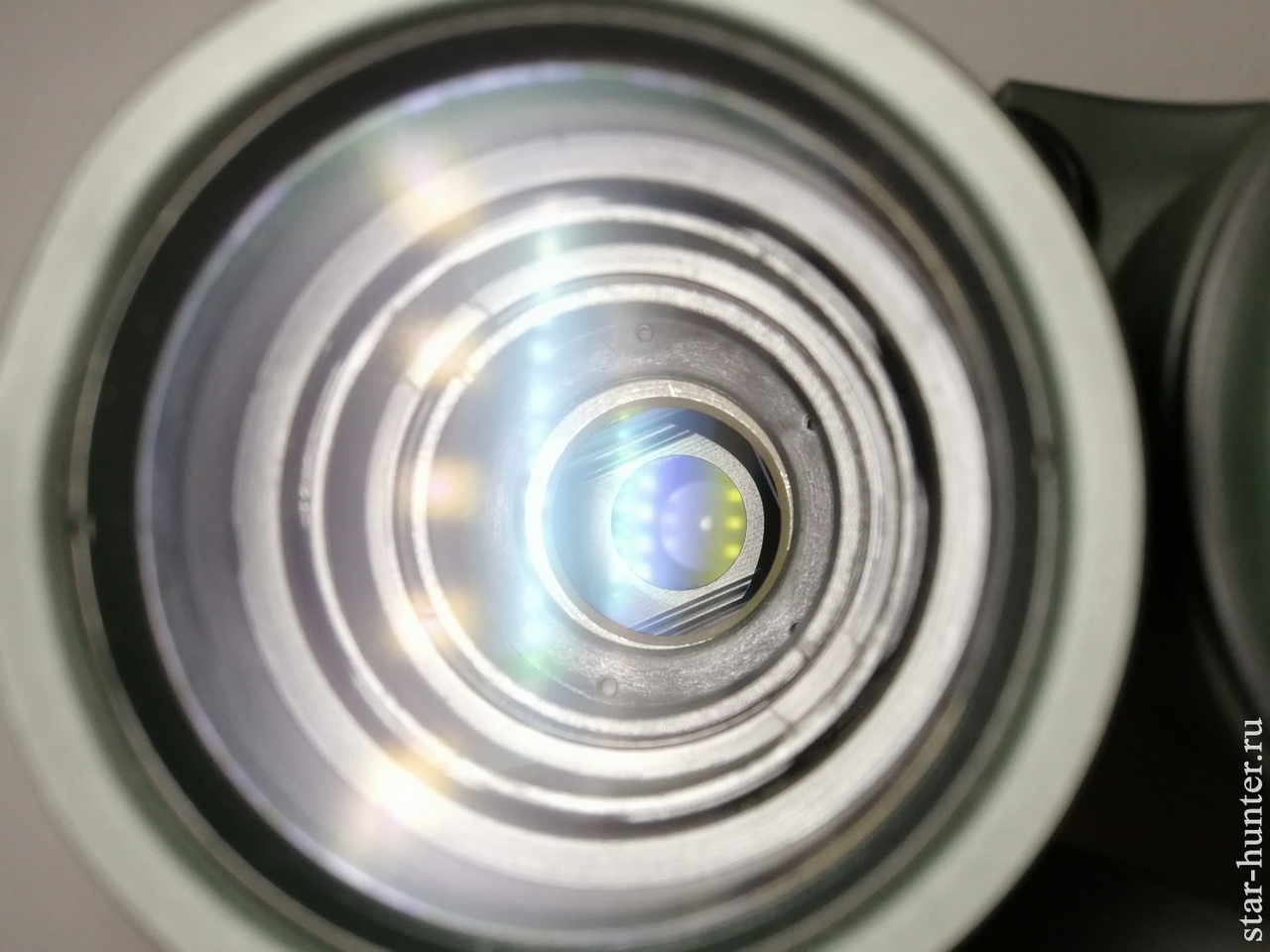
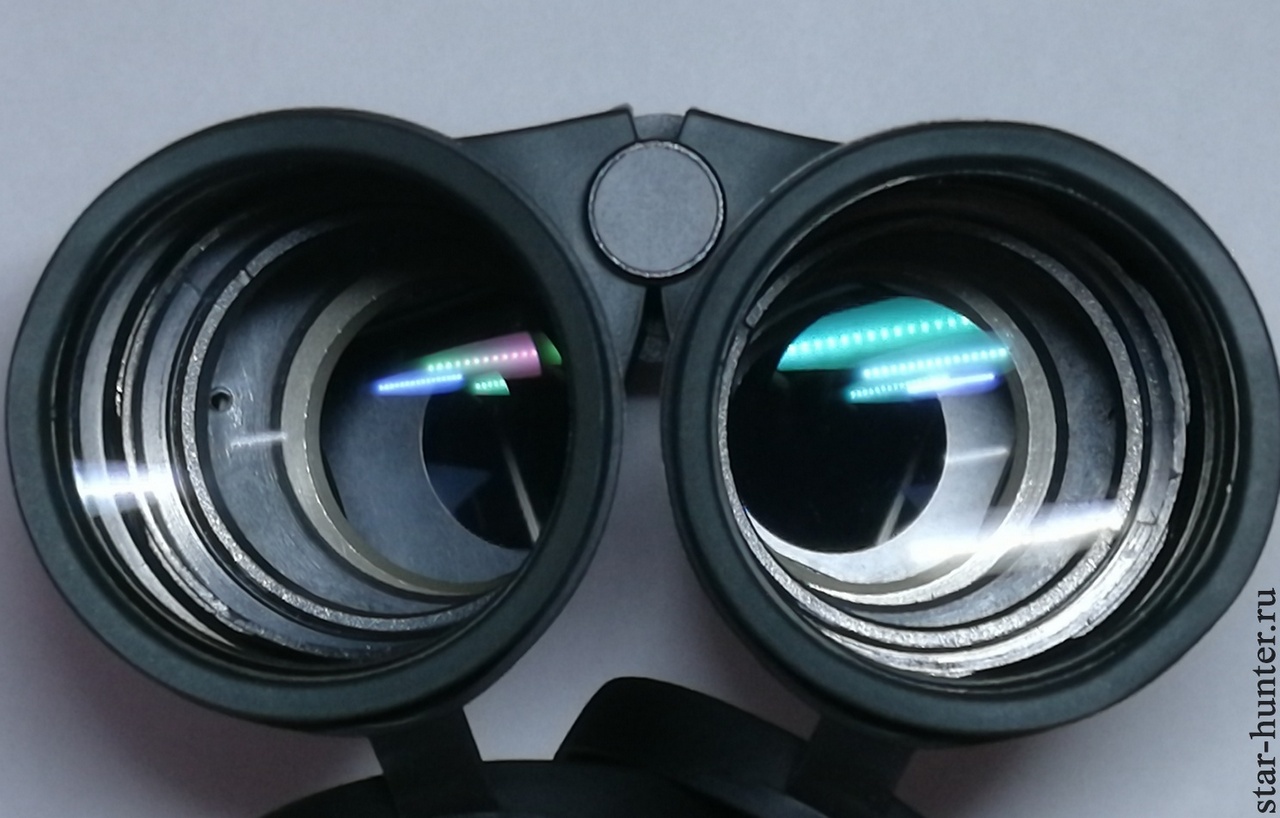
Eye lenses are large, 24.5 mm. The color of the reflections from the eyepieces is green (different shades), blue, dull, colorless (gluing lenses). The measured field of view of the eyepieces was 45 degrees. The visible field of view of binoculars was 5.7 degrees (estimated by the stars in Lira). This is noticeably less than the claimed field of 6.5 degrees. The measured exit pupil size is 6.8 mm. Based on this, it is possible to calculate the real increase – it is equal to 55 6.8 = 8.09x, which practically corresponds to the declared one.
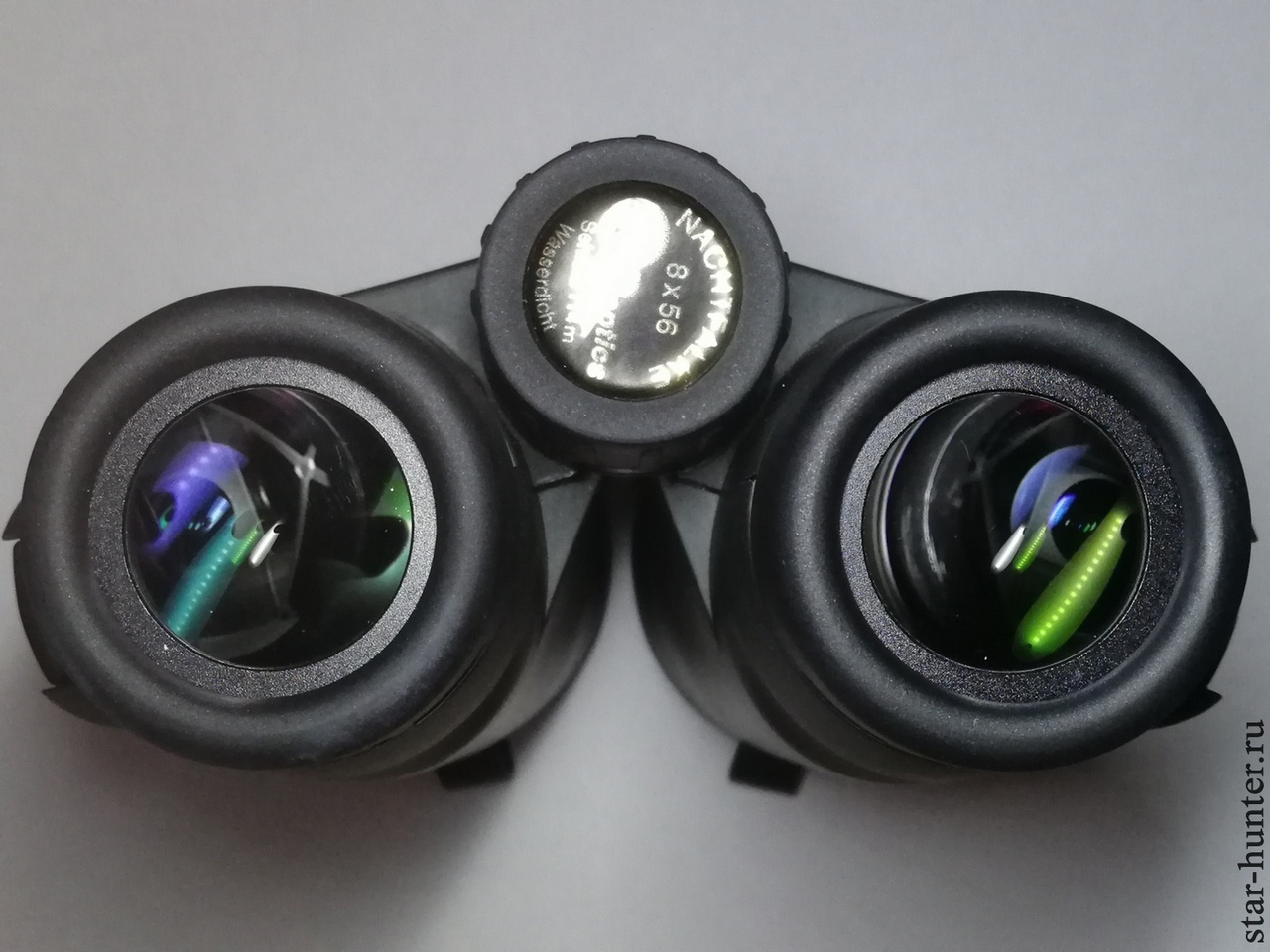
The exit pupils are round, but are slightly cropped from 4 sides tangentially. Outside the exit pupils, there are several parasitic reflections inside the enclosure.
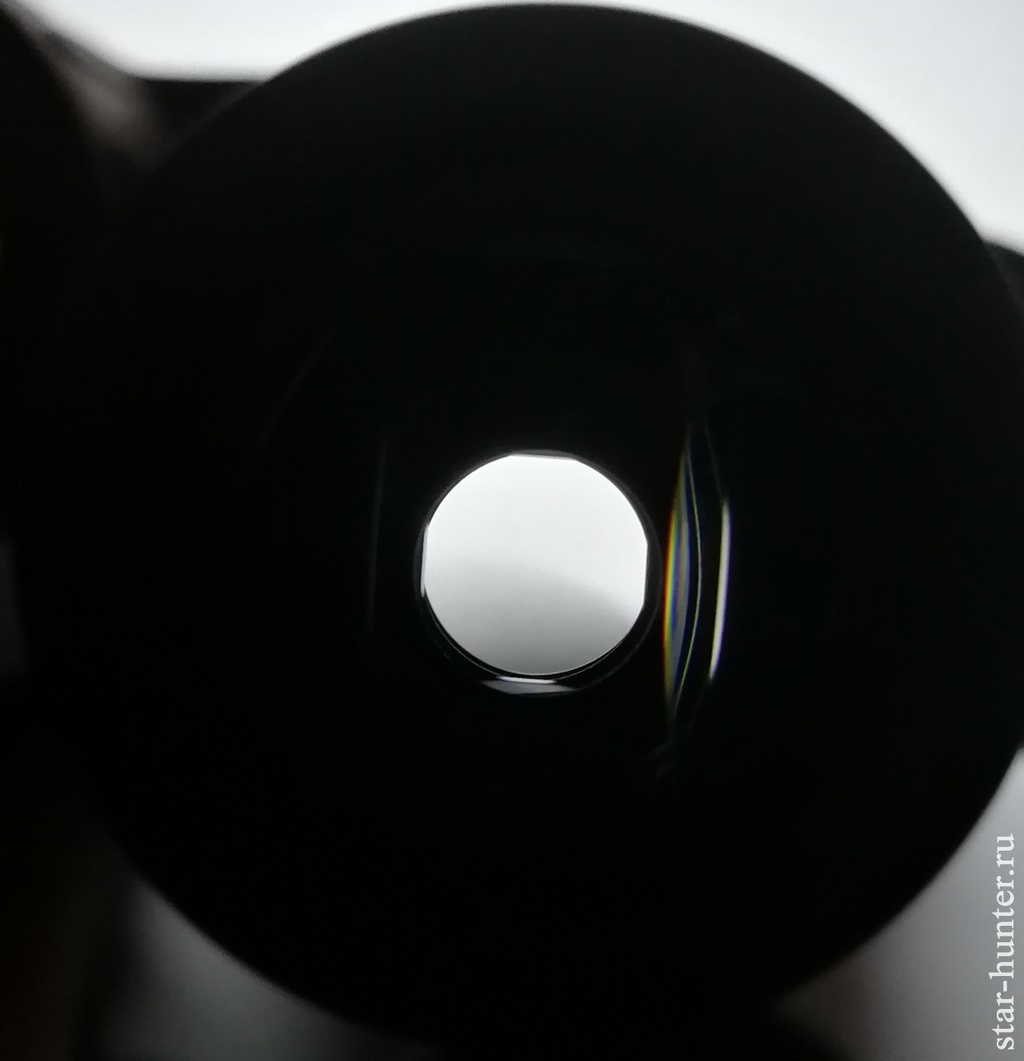

The measured eye relief from the surface of the lens was 25 mm – a lot! The eyecup is twisted by 6 and 13 mm, fixed in several positions. In the screwed position, the eyecup protrudes 3 mm relative to the eye lens. When observing without eyeglasses, the progress of the eye flaps is even somewhat insufficient to rest against them with eye sockets – one has to keep the binoculars a couple of millimeters further from the eyes, since the exit pupil is 10 mm from the fully uncoupled eyecup. Observations with glasses are possible both with fully screwed eyecups and at their first position. Eyecups are made of rubber, non-removable, glued to metal retractable tubes.
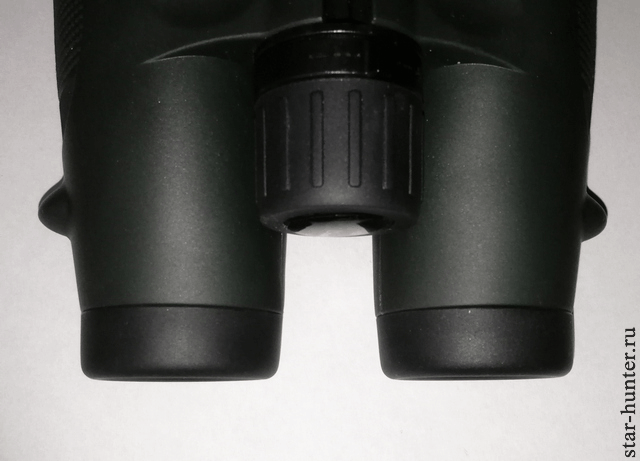
Focusing.
Focusing is carried out by a large ribbed drum with a diameter of 32.5 mm. Focusing smooth, soft, with little effort. The full focus range is approximately 2 turns.

Adjusting the diopter under the right eye is implemented by a small joystick lever in front of the drum. When this occurs, the shift of the tube of the intermediate focusing lens of the lens. Such a system seemed convenient to me. There is a slight play. Randomly knock down the joystick will not work, the course is quite tight.
In the binoculars declared system “Smart focus”, that is, after the initial adjustment of the focus of the eyes themselves are focused on nearby objects. In practice, I still enjoy using the manual focus.
Star test.
The binoculars immediately impressed me with an abundance of dim stars. In direct comparison with Nikon Sporter EX 8×42 and Meade Rainforest 8×42 binoculars, an obvious increase in the brightness of the background and the number of stars caught my eye. On ground-dim objects, DDoptics 8×56 binoculars also showed a total superiority in image brightness and detail.
The field of view of binoculars is small, it is typical for binoculars with the 8×56 formula and is quite enough for observation, but the effect of “immersion” into space is not the same as that of wide-angle binoculars (for example, Meade 8×42 Rainforest Pro). In the central third of the visual field, the stars look sharp, then the image quality deteriorates. Bright stars no longer look like punctate, but like small spots surrounded by a faint radiant halo – most likely these are features of the work of my eyes with a large exit pupil. By the optics of binoculars, these artifacts are hardly relevant, since the rotation of binoculars remain in place. At the edge of the field of view – weak vignetting. The main aberrations are coma and slight curvature of the field.
The eyes during observations do not get tired, the bright star test showed excellent collimation of binoculars. Glare on the moon is not detected.
Chromatism is small in both night and daytime observations. X-rays from bright stars are barely noticeable – the phase correction on the prisms works.

I liked the binoculars with day and twilight observations. The image is bright, juicy, contrast. The edge of the field of view is sharp and framed by a narrow yellow-red ring. I did not notice any color distortion. The color border is very small and noticeable closer to the edge of the field of view. It is easy to combine the eyes with the exit pupils of binoculars. In twilight it is visible almost the same as with the eye, only much closer and more detailed. The only drawback is a noticeable distortion, but for me personally, it does not problem.

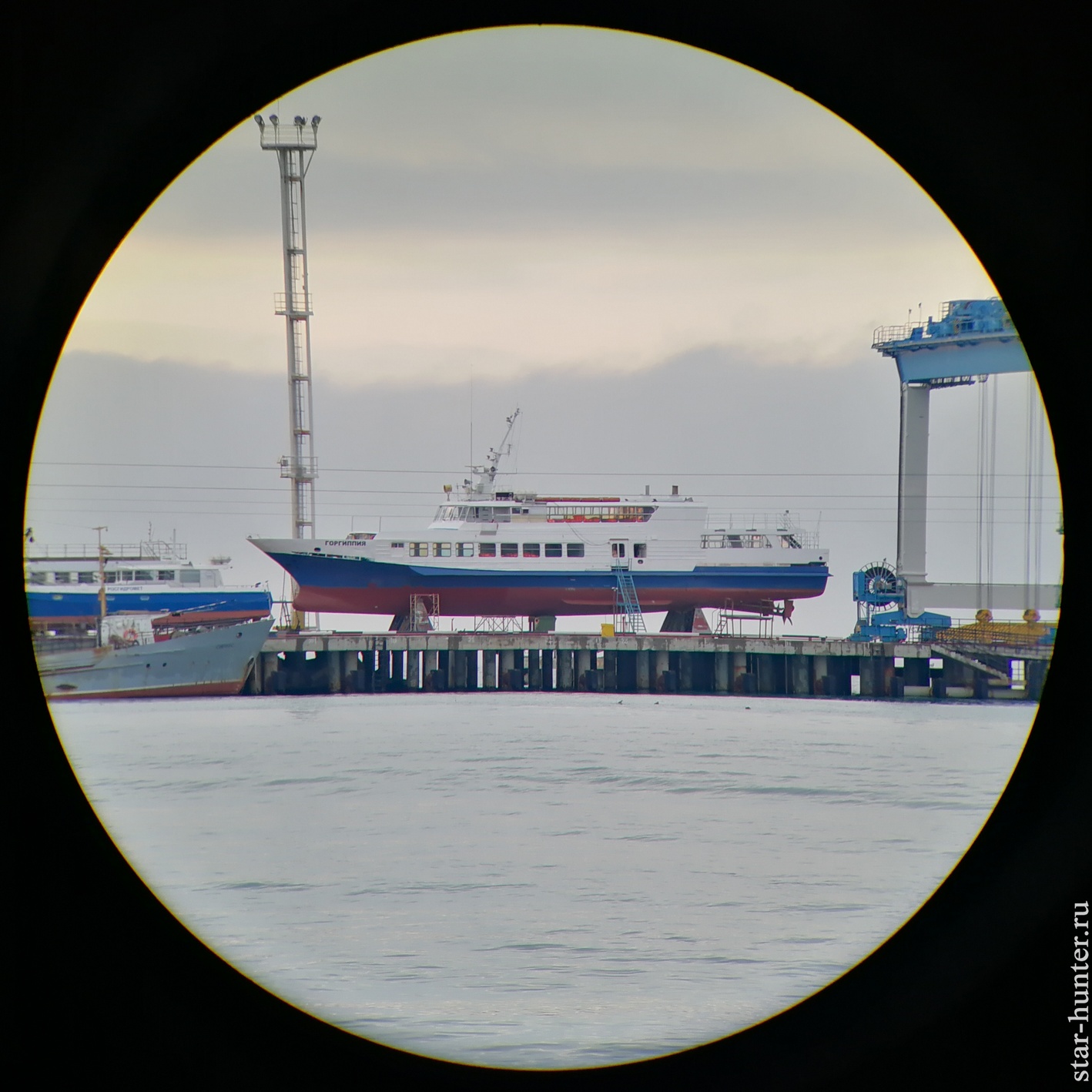
Summary.
+fully coated optics
+high brightness
+good field sharpness, good contrast
+very low chromatism
+working phase correction
+good color rendering
+excellent collimation
+good blackening
+small size and weight for 8×56 binoculars
+long eye relief
+comfortable durable bag
-aperture less than stated
-visible field of view less than stated
-noticeable distortion
-insufficient length of the eyecup
-small FOV of eyepieces
-backlash joystick settings diopter right eye
-stains on the inner lens
– narrow belt bag.
Despite the shortcomings, I really liked the binoculars and stayed with me. I use it for astronomical observations of the city — while an astrograph telescope takes pictures, I admire star clusters and bright nebulae. Weight and dimensions allow you to take binoculars with you for a walk. Binoculars definitely recommend, if not confused by a small field of view. In terms of price/quality binoculars is very good.
Analogs.
I found several models of binoculars very similar in appearance to DDoptics 8×56. The main sign is the diopter settings joystick. There are several modifications of binoculars – both with ED glass and without.
The beginning is most likely from binoculars Visionking 8x56ED.
Another same models:
Fomei Leader 8×56 DCF
Vortex Vulture HD 8×56
Kowa BD 8×56 XD Prominar
Eyeskey 8×56 (apparently, without ED-glass).
Binoculars are different – both coatings and light transmission are different. Nevertheless, it is obvious that they are made in one factory. To take them or not – decide for yourself.